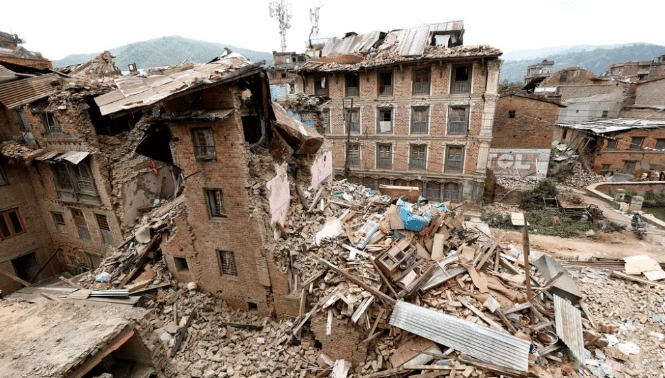On the east coast of Sri Lanka, in the village of Pandiruppu, a man sits among the wreckage of his wrecked home. 6 January 2005 KIERAN DOHERTY, REUTERS
One of the deadliest natural disasters is an earthquake. Earthquakes happen when the lithosphere suddenly releases energy, causing seismic waves that cause the Earth’s surface to shake.
Today (6 February), a powerful earthquake with a magnitude of 7.9 slammed central Turkey and northwest Syria, killing more than 300 people, wounding hundreds more when buildings fell, and sparking searches for survivors buried under the rubble throughout the wintry area. The earthquake, which occurred in the early hours of a winter morning, was felt in Lebanon and Cyprus as well. There will probably be more fatalities.

Turkey and Syria are being rocked by a 7.9 magnitude earthquake that has left over 500 people dead.
However, both in terms of the number of fatalities and magnitude, Monday’s earthquake wasn’t the deadliest one ever observed.
The strongest earthquake ever recorded occurred on May 22, 1960, in Valdivia, Chile. It was rated between 9.4 and 9.6 on the moment magnitude scale by several researchers. There were about 1,655 fatalities from that earthquake.
According to data from Statista and the United States Geological Survey, the following earthquakes have been the deadliest in recent memory:

African continent earthquake (2004)
The 2004 Indian Ocean earthquake, which claimed about 227,898 lives, was the most deadly incident.
On December 26, 2004, an earthquake with a moment magnitude scale (Mw) of 9.1–9.3 struck with its epicentre off the west coast of northern Sumatra, Indonesia.
It attained a Mercalli intensity of up to IX in certain places and was brought on by a rupture along the fault between the Indian Plate and the Burma Plate.

One of the deadliest natural disasters in recorded history, the earthquake triggered a catastrophic tsunami with waves as high as 100 feet, destroying villages throughout the Indian Ocean’s surrounding coasts and killing an estimated 227,898 people in 14 different nations.
Earthquake in Haiti (2010)
On January 12, 2010, an earthquake with a 7.0 Mw magnitude occurred in Haiti.
The epicentre was around 25 kilometres from the capital of Haiti, in the Ouest department, close to the town of Leogane.
At least 220,000 people are thought to have died as a result of the earthquake, according to sources in the media.

Earthquake in China (2008)
Sichuan, China, was struck by an earthquake measuring 7.9 Mw on May 12, 2008. The province’s capital Chengdu is 80 kilometres (50 miles) to the west-northwest of the earthquake’s epicentre.
At least 87,587 people died as a result.
Sichuan, China, was struck by an earthquake measuring 7.9 Mw on May 12, 2008. The province’s capital Chengdu is 80 kilometres (50 miles) to the west-northwest of the earthquake’s epicentre.
At least 87,587 people died as a result.

Beijing and Shanghai, which are 1,500 and 1,700 kilometres apart from each other, as well as Bangkok, Thailand, and Hanoi, Vietnam all felt the quake. Office buildings in Beijing and Shanghai, Bangkok, Thailand, and Shanghai also felt the quake.
Nepal earthquake (2005)
On October 8, 2005, an earthquake struck Azad Kashmir, which is governed by Pakistan. It measured a moment magnitude of 7.6 and was centred close to the city of Muzaffarabad. Millions of people were displaced, over 86,000 individuals lost their lives, and a similar number were hurt.
In addition to China’s Xinjiang area, the earthquake was also felt in Afghanistan, Tajikistan, India, and India.

Earthquake in Iran (2003)
An earthquake occurred in the Kerman province of southeast Iran on December 26, 2003.
The shock was 6.6 in terms of moment magnitude. At least 34,000 people died and up to 200,000 were injured as a result of the earthquake in Bam, which was extremely catastrophic.
On December 26, 2003, there was an earthquake in the Kerman province in southeast Iran.
The shock had a moment magnitude of 6.6. The highly disastrous earthquake in Bam resulted in at least 34,000 fatalities and up to 200,000 injuries.

On March 11, 2011, a tsunami brought about by a magnitude 9.0 earthquake in northeastern Japan claimed the lives of over 15,000 people and left over 6,000 more missing.
The earthquake, which had its epicentre in the Pacific Ocean 72 kilometres (km) east of Japan’s Tohoku region’s Oshika Peninsula, lasted for around six minutes and triggered a tsunami.
Earthquake in Mexico City (2017)

On September 19, 2017, an earthquake of a magnitude of 7.1 hit Mexico City. More than 300 people were murdered, and countless more were injured.
Earthquake in Nepal (2015)
A 7.8-magnitude earthquake rocked Nepal on April 25, 2015.
More than 8,000 people were murdered and almost 20,000 were injured.
tsunami in Indonesia (2018)

On September 28, 2018, an earthquake of a magnitude of 7.5 rocked the Indonesian island of Sulawesi, triggering a tsunami that left over 4,300 people dead and thousands more injured.
Tsunami in Indonesia (2022)

On November 21, 2022, a 5.6 Mw earthquake occurred close to Cianjur in West Java, Indonesia.
Between 335 and 635 persons died and 7,729 were hurt as a result of the earthquake.
ALSO READ THIS: Elon Musk Said That Spacex Might Try To Launch a Starship In March.

